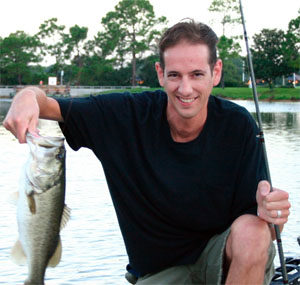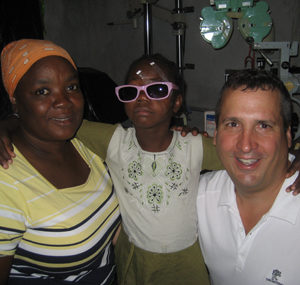
Jun 7, 2010 | Recipient Stories

Chris was able to return to fishing after his cornea transplant.
Tying a fly for fly fishing can be difficult for someone even with 20/20 vision. But for an individual suffering from a blinding eye condition, the challenge can be downright impossible, stealing away the joy of a sport he once loved.
For years, Chris of Kansas City had been suffering from eye problems that left his vision compromised. “Everything was a big haze,” he remarked. “I would see ghost images, like four or five visions of the same chair. There were a lot of halos, a lot of flares, rings around taillights. The haze filled up my whole vision, making it hard to do anything.”
In his early 20s, Chris was diagnosed with keratoconus, a disorder that causes the cornea to become distorted. Chris was fitted with hard contacts to correct his eyesight, but as he grew older, the contacts became more cumbersome while his vision continued to deteriorate. Keratoconus affected his job in I.T., limited his ability to drive, and worst of all, affected his passion for fly fishing.
The Escape from Blindness
Finally, in 2004, Chris underwent a cornea transplant on his left eye under the care of Dr. Joseph Tauber of Tauber Eye Center. Although the first three weeks of his recovery were highly uncomfortable, Chris now has 20/20 vision when he wears a soft contact.
Said Chris, “Everyone wonders – how do you do that? You actually got your eyeball cut open? I think one of the reasons people don’t get the cornea transplants they need is because it’s a scary thought, but it’s so worth it in the long run. There’s nothing I wouldn’t have done to get my vision back.”
The first cornea transplant went so well that Chris underwent his second in 2009. “Although my vision’s not back 100%, it’s amazing I have 20/40 vision even without my contact on. I’m not there yet, but I’m better than I was.”
While Chris has been blessed with better eyesight, the journey has been bittersweet. Because of his condition, Chris’ donors had to be younger than the recipient and the corneas less than 72 hours old. “It’s such a double-edged sword. What’s good for somebody like me meant something bad had to happen to someone else. The hardest thing is knowing what another family was going through.”
Today, thanks to the gift of his donor families, the talent of Dr. Tauber, and the support of Chris’ optometrist, Dr. Jill Smith of Precision Optics, Chris is back on the water and enjoying his favorite sport. Only now it’s the fishes’ turn to be concerned about Chris’ vision.
Click here to watch Chris’s interview.

May 31, 2010 | Recipient Stories

One generous donor family granted the gift of sight to two brothers.
As identical twins, Garry and Larry have shared a lot in common – careers in the insurance industry, a love for fishing, and unfortunately, Fuchs’ dystrophy, a genetic disease which slowly stole their eyesight over the years.
The only hope to restore their lost vision would be a cornea transplant in each of their eyes. In a unique twist of fate, the two brothers who shared so many things over the years were about to share something else – a date for their cornea transplants.
For years, poor eyesight had hindered both brothers’ lifestyles. Larry, for instance, was forced to retire early because he could no longer read clearly at work. In addition, the bad eyesight affected their favorite pastime. “My brother and I like to fish, but the Fuch’s made it very difficult,” said Larry. “Trying to tie a hook on to a line – now that was a lengthy process.”
In December 2010, a caring donor family made the heartfelt decision to donate their loved one’s eyes to save the vision of others. The corneas were offered by Saving Sight to Dr. Timothy Cavanaugh of Cavanaugh Eye Center in Overland Park, Kan. who immediately scheduled surgeries for the brothers on the same day.
Larry underwent the surgery on his right eye first, followed by Garry. It was only after the surgeries did the brothers learn their corneas were from the same donor.
While Larry and Garry are still in the recovery process, their sight has improved dramatically. Garry, who had a transplant on his left eye in October 2010, is seeing a significant difference in his eyesight already, and Larry will be undergoing a transplant on his left eye in 2011.
“We’re thrilled with how the transplants have turned out,” said Larry. “We have been dealing with this disease for some time, so the opportunity to get our transplants was wonderful.”
Because of their experience, Larry and Garry encourage others to consider joining their state’s eye and organ donor registry.
Remarked Larry, “When you’re asked at the DMV if you’d like to be a donor, you take it for granted. You think it’s not really a big deal, but it is a big deal to someone else. If you haven’t needed a heart or kidney or cornea, you might not appreciate it. But after getting our transplants, we have a whole new appreciation for what others have gone through.”
To learn more about joining a registry, visit www.donatelifemissouri.com in Missouri or Kansas’ new first-person consent registry at www.donatelifekansas.com.

May 30, 2010 | Donor Stories

Mason changed the lives of two cornea recipients through the gift of sight.
From the moment he entered the world, Mason Kempf made an impact on everyone he met through his big smile and bigger heart. By the time he left this world in March 2011, that impact wrapped around the globe and showed complete strangers how one little boy can change the lives of many.
Mason was an intelligent, active child who loved Boy Scouts, soccer, video games and playing with his brother and sister. By second grade, he already planned to attend University of Missouri and become a scientist. However, a diagnosis of diffuse pontine giloma, a brain tumor, in April 2010 changed his path in life.
For the next several months, Mason received treatment at St. Jude Children’s Research Hospital in Memphis until finally his medical team acknowledged there was nothing more they could do. Mason was able to return to his hometown of Overland Park, Kan., and eventually spent the last weeks of his life in hospice care.
His mother Andria chronicled his journey at masonarik.blogspot.com – a touching site that struck a chord with readers. People immediately reached out to help – the Elves of Christmas Present worked on Christmas Eve to create a snow-covered wonderland to grant his holiday wish. In February, Valentine cards were received from around the world, cheering this brave fighter on.
Due to this outpouring of kindness, the family knew they had to find a way to help others. Once they were told there was no cure for Mason’s illness, his father began researching the possibility of eye and kidney donation, talking openly with Mason’s doctors and broaching the subject with hospice providers. Donation hit especially close to home since Mason’s grandmother, who has diabetes, will likely need a kidney transplant herself one day.
Said Andria, “We felt like what happened to us was so tragic, but from day one we looked for the good in the situation. If there was anything we could do for someone else, we would do it. We learned so much from our journey, especially in regards to compassion from complete strangers. It was up to us to give back to help someone else out.”
On March 29, 2011, Mason passed away at home. A few days later, cornea recipients in New York and California received his gift of sight.
Today, Mason’s kindness toward others is still being felt through one special project.
A Love for Tigers Lives on
Whether at home in Kansas City or during his treatment in Memphis, Mason loved spending his free time at each city’s zoo, in particular visiting his beloved tigers.
“On the day he was born, Mason received a giant stuffed tiger,” remarked Andria. “From that day on, he always loved tigers and felt a special connection to them, especially once he got sick. Tigers are brave and courageous just like he was. Plus, the tigers at the Kansas City Zoo are near extinction, so like Mason, they have their own battle to fight.”
Upon seeing the Memphis Zoo’s open, natural tiger habitat, Mason was looking forward to the Kansas City Zoo creating something similar for its own tigers. Spurred by Mason’s passion for the project, his parents met with Kansas City Zoo officials to see how they could help provide support the plan for its upcoming tiger exhibit renovation.
A memorial for Mason was soon set up at the Zoo to raise funds for the tiger sanctuary. On June 21, 2011, which would have been Mason’s tenth birthday, the Kempfs encouraged individuals to send a birthday card and donation to the Zoo’s memorial fund in honor of their son’s final wish. Contributions may continue to be sent to:
Kansas City Zoo
Attn: Laura Berger “In Memory of Mason Kempf”
6800 Zoo Dr
Kansas City, MO 64132
For additional details on Mason’s mission, please visit masonarik.blogspot.com.
Said Andria, “We’re hoping the exhibit will convey to people the person Mason was. He taught us to carry on and help in the lives of others. We want to impact other people so they too can make a difference and follow in his footsteps.”

May 29, 2010 | Recipient Stories

Dr. Andrew Moyes poses with 11 year-old Miriam who receive a second cornea transplant in 2011 with tissue provided by Saving Sight.
In a developing country like Haiti, vision loss can be a devastating blow to an individual’s ability to work and support one’s self, not to mention his or her entire family. Glaucoma, cataracts, corneal blindness – disorders that can be treated here in the U.S. – can sink a poor family into complete and desperate poverty. In Haiti, blindness can be lethal.
Yet, in the midst of this darkness, lies hope for thousands thanks to nonprofit organizations and mission groups as well as the dedicated volunteers who support them. Volunteers like our partner in sight, Dr. Andrew Moyes of Moyes Eye Center in Kansas City, MO, who has performed sight-saving surgeries on nine mission trips to Haiti, including corneal transplants using gratis donated tissue provided by Saving Sight.
An Ophthalmologist Discovers His Mission
When Dr. Moyes was first approached to donate his time at the Northwest Haiti Christian Mission (NWHCM), he made a financial contribution, but declined the invitation to Haiti. Soon after, as he watched a video on everything the Mission offered residents – the schools, feeding programs, birthing center, orphanages – he was moved to take his first Haitian mission trip.
In 2004, Dr. Moyes joined the surgical team at the NWHCM in the Northwest Zone of Haiti, the poorest state in the poorest country in the Western Hemisphere. On his first mission trip, Dr. Moyes and his fellow doctors performed 60 cataract surgeries; by his eighth trip in February 2011, that number grew to 162 performed in just four-and-a-half days.
In addition, the surgical team is trying to ease the devastating effects of glaucoma in the country. Said Dr. Moyes, “Glaucoma is so rampant in Haiti that one-fourth of people that we see in our clinic are blinded by the disease. Glaucoma isn’t even one of the World Health Organization’s priorities because it is so hard to treat.” However, through preventative eye exams, laser treatments to halt further vision loss, and glaucoma medications donated by Alcon and Allergan, the doctors are making headway.
“We’re trying to push back how quickly people go blind. Maybe Lord willing, someone will go blind in 12 years instead of two. When you see healthy 30 year-olds who want to work, but have no light perception because of glaucoma to perform a job, it’s enough to break your heart.”
Dr. Moyes also uses his expertise as a renowned corneal surgeon to save sight. In August 2011 for instance, he transplanted gratis tissue from the Eye Bank to restore vision to three individuals in need, including a 26 year-old male whose corneal scar affected his ability to work and an 18-year-old female who traveled from Port-au-Prince to this rural area of the country to save her vision.
But one transplant recipient who has stuck out in his mind is Miriam, an 11 year-old suffering from congenital hereditary endothelial dystrophy, a condition that thickens and clouds the cornea. Miriam received a corneal transplant in one eye two years ago – the result was so remarkable she was able to move from a special needs orphanage to one which provided her more independence. Because of a donor family’s incredible generosity here in the Midwest, Dr. Moyes was able to save her sight in her other eye, helping to provide her with a solid foundation for her future.
Continuing to Serve Both at Home and Overseas
The goal of these medical mission trips is not to perform the surgeries and walk away, but to truly help the Haitian people help themselves. Dr. Moyes and his colleagues are focused on teaching ophthalmologists in Haiti the skills they need to offer services throughout the year. In addition, because patient follow-up is so crucial after eye surgery, a Haitian ophthalmologist is available at NWHCM four days a month for follow-up exams and maintains contact with the medical team on any pertinent issues.
Even among the overwhelming circumstances – the backlog of patients, the country’s challenging infrastructure, the inability to help all who need assistance, Dr. Moyes finds hope and joy in the faces of those he’s helped. So much so that he has integrated his passion for the Haiti people into his professional life at Moyes Eye Center and into his personal life, now that his wife and four children often join him on mission trips.
“There’s not a day that goes by that I don’t think about what needs to be done, what we can do to make eye care better in Haiti. Seeing the joy in people’s faces when they realize they can see again brings such joy to my heart. As anyone on a mission trip will tell you – you go there to bring blessings to others, but you will be blessed a hundredfold by them. It feels so right to serve these people.”
We at the Eye Bank could not provide Dr. Moyes with gratis tissue for his mission trips without the compassion of donor families and the contributions of our generous financial supporters. To learn how you can pledge to give sight, whether around the world or in your own backyard, please visit our About Cornea Donation page.

May 26, 2010 | Recipient Stories
 Each school day, first graders in Centralia, Kansas open their books and their minds thanks to one special teacher. As a Reading Recovery teacher, Marsha helps those children who are struggling with reading gain the skills they need to become stronger students.
Each school day, first graders in Centralia, Kansas open their books and their minds thanks to one special teacher. As a Reading Recovery teacher, Marsha helps those children who are struggling with reading gain the skills they need to become stronger students.
Yet, until recently, Marsha was struggling with reading herself – only her issue was due to her declining vision.
At age 19, Marsha was diagnosed with Fuchs’ dystrophy, a genetic condition in which the cornea progressively deteriorates. By the time she was in her late thirties, her treatment included a constant regimen of eye drops, ointments and appointments.
The Fuchs’ dystrophy continued to worsen – the thick inner layer of her corneas collected moisture during the night, leaving her vision incredibly cloudy each morning and making both driving and reading extremely difficult.
Finally, in 2008, Marsha underwent a cornea transplant on her left eye, and in 2012, on her right eye. Although she faced complications with her initial transplant, today her vision is “amazing.” She no longer faces vision cloudiness every morning of her life and can now participate in her favorite activities, including exercising, traveling to see her grandchildren, and reading, with crystal clear vision.
Said Marsha, “I think of my donor often when I realize I’m reading the morning paper with no problems or looking up a phone number. I live in a little town, so traveling to the city on a weekend and being able to go early and face the sunlight is such a blessing. There’s such a feeling of independence with this gift.”
Marsha’s transplant also brought a new friend into her life – in Spring 2012, she and her most recent donor’s twin sister began corresponding regularly about their experiences, giving Marsha more insights into the woman who gave her the gift of sight.
In addition, the correspondence letters touched yet another person when Marsha shared them with a colleague whose husband had been an organ donor. The two coworkers were able to see first-hand both sides of the donation journey and the impact it has on some many people’s lives.
To learn more about joining the donor registry in Kansas, visit our donor page or the Donate Life Kansas website.







